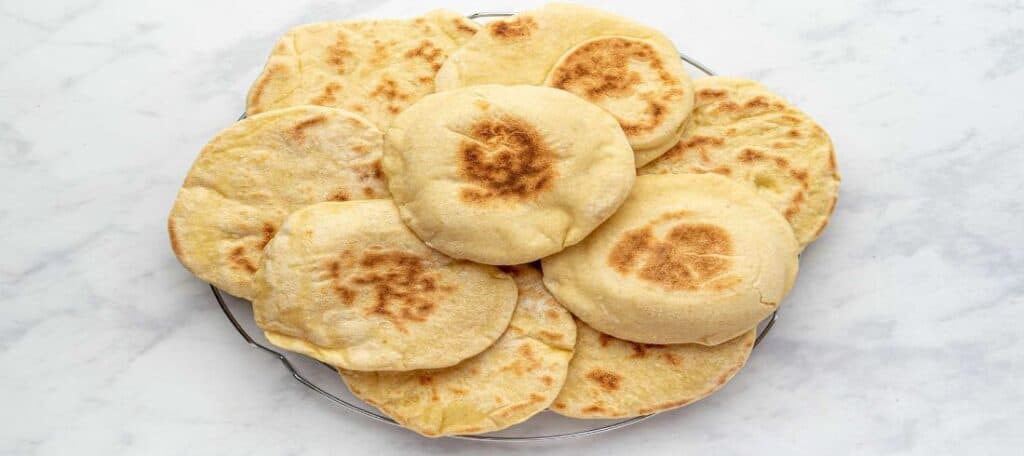
Each culture picks its favorite bread, and Morocco loves batbout, a key part of their food scene. It’s famous for its various uses and loved for its tasty feel. Batbout comes in different sizes and fits all parts of a Moroccan meal from big breakfasts to tasty dinner sides. With this easy batbout recipe, you’ll learn to make this soft semolina bread on your stove. Start your day with a touch of Morocco. Let this yeast bread turn your meal into a real Moroccan feast.
Discovering Batbout: Morocco’s Stovetop Pita Bread
Join us as we explore batbout, the Moroccan pita that stands out in the Mediterranean. African bread comes in many shapes, but batbout is special. It’s cooked right on the stove and is a beloved part of Moroccan food.
What is Batbout?
Batbout isn’t just any bread; it’s a piece of Moroccan tradition, fluffy and small. It’s made on the stove, not in an oven like other pitas. This makes it soft and chewy. Batbout goes well with many dishes, thanks to Morocco’s mix of Arab and Portuguese influences.
The Cooking Method: Stovetop vs. Oven
Batbout is different because it’s cooked on the stove, not in an oven. Many African countries use the stovetop for bread. In Morocco, this method makes batbout tender. It’s perfect for stuffing or dipping, which shows how cooking affects its taste and texture.
Uses for Batbout in Moroccan Cuisine
Batbout is used in many ways in Moroccan food. It’s not just for sandwiches. You’ll find it in breakfasts and with sweet and savory pastries. For example, at the Four Seasons Hotel Casablanca, there are over 35 pastries. Batbout is also great with rich tagines or flavorful mechoui, adding to the meal’s taste.
Batbout is everywhere in Moroccan food. Discovering it means finding a part of Moroccan culture.
Morocco’s breads, including batbout, are key to its culinary history. They carry stories and skills from many generations.
Step-by-Step Guide to Making Perfect Batbout
Starting your batbout-making journey means diving into the heart of Moroccan cuisine. You will learn about the traditional methods and ingredients that give this bread its unique texture and taste. This guide will show you how to make delicious pita bread. It’s perfect for many Mediterranean meals. Each step, from picking the right ingredients to storing your bread, is key to making perfect batbout.
Ingredients and Substitutes
Great batbout starts with the right mix of ingredients. Although traditional recipes use flour, semolina, yeast, salt, and water, you can make changes. You can swap some ingredients to fit your diet or taste, and still get excellent bread.
Preparing the Yeast Dough
This guide gives you step-by-step instructions to prepare the yeast dough. It’s a crucial part to get a fluffy batbout. By being patient and careful at this stage, you’ll get a dough that’s the perfect mix of stretchy and soft.
Kneading and Resting: Crucial Steps for Fluffy Batbout
Kneading and resting the dough are key to making your batbout fluffy. Knead well to make the gluten work, then let it rest. This lets the dough rise the right way. That’s how you get that special pita pocket in each batbout.
Cooking Tips for Achieving the Signature Pita Pocket
Batbout is known for its pita pocket, which comes from cooking it just right on a stove. This guide has all the cooking tips you need. Paying attention to how hot the stove is and how long you cook the batbout is crucial.
Storing and Reheating Batbout
This guide also talks about the best ways to store and reheat batbout. Doing this the right way keeps it fresh and tasty. Whether you’re eating it now or later, these tips help keep your batbout delicious for any meal.
Conclusion
As we end our guide on batbout, we see tradition blend with simplicity in Moroccan food. Making batbout at home lets us explore Morocco’s rich culture. Every soft bite takes you straight to the lively streets of Marrakesh. This bread is versatile, perfect for sandwiches, breakfast, or alongside Moroccan meals.
Global studies show Moroccan eating habits are healthy. Like the Mediterranean diet, Morocco’s food offers many health benefits. It fights inflammation and supports long-term health. So, making batbout at home does more than please the palate. It’s also a step towards better health.
Making batbout is an act of preserving tradition and eating healthily. It brings joy to your meals with its tasty pockets and genuine flavor. This approach to food boosts our health. Thus, this conclusion is not just an ending. It’s an invite to dive into the world of Moroccan pita and healthy living.








